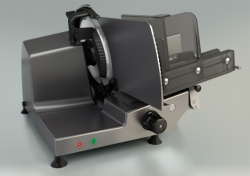
The manual slicer Validoline VSC 280 from Bizerba has again been awarded the seal of quality from the BVLK, and can therefore continue to be sold with the additional mention of “recommended by the Federal Association of German Food Inspectors”. The BVLK regularly commends products that improve hygiene in the food industry – yet Germany still has no compulsory hygiene standards for slicers.
The causes of poor hygiene, which leads to premature spoilage of food, are numerous and diverse. Alongside inappropriate storage and inadequate transportation, poor hygiene in processing is often the cause of contamination of all kinds. Therefore restaurant and catering companies along with bakeries and meat-processing businesses wanting to minimise the risk of contamination should pay attention to certain points when selecting their technical equipment:
- Always cast a critical eye over the item’s construction:
Slicers should be easy to clean at all times, and product residues should be thoroughly removed regularly and as frequently as possible. At busy times when customers are queuing up, this is easier said than done. In order to achieve optimum cleaning results with as little effort as possible, the machine housing should be in one piece only and the side edge slightly raised. This way, liquids do not spill onto the counter or floor, but run along the drainage channel of the stop plate to the lowest point in the middle of the machine housing, where they can be conveniently removed. This prevents the machine from becoming dirty and reduces the risk of contamination to a minimum.
- Pay attention to the surface texture:
Slicing machines usually have surfaces made of stainless steel or “eloxal” aluminium. A finishing material such as Ceraclean, however, offers better non-stick and gliding properties. Liquids drip off and fatty or very sticky residues can be removed more quickly and thoroughly. Mould growth is thus effectively prevented and the impeccable hygiene of the slicer consistently ensured. Ceraclean is also notable for its increased resistance to chemicals. Removable components can be cleaned in a dishwasher, and overall cleaning time is thus reduced by fifty percent.
- Keep an eye on the temperature:
With products that are difficult to slice, machines can use up a lot of energy and rapidly heat up. At the same time, the food product on the slicing surface also heats up, which can lead to faster deterioration. The devices should therefore boast an intelligent engine control that adjusts energy consumption automatically to the product being sliced and the relevant capacity situation. This way, the machine uses less electricity on average, remains cooler and food stays fresh for longer. At the same time, it is possible to install a closed base plate without ventilation holes, which significantly reduces the risk of a bacterial germ load.
- Cleaning without laborious handling:
All the components of the machine must be easy to reach, to disassemble and to clean. The distance between the motor tower and the blade should be great enough that the machine and its blade can be cleaned from all sides. It should be possible to detach the carriage instantly with a snap lock and remove it for cleaning. Components like covers and residue holders should ideally also be easily removed by means of a clip mechanism. The user shouldn’t have to undo any screws; rather the components should detach with a click so they can then be cleaned either by hand or in a dishwasher.
Source: Bizerba GmbH & Co. KG










